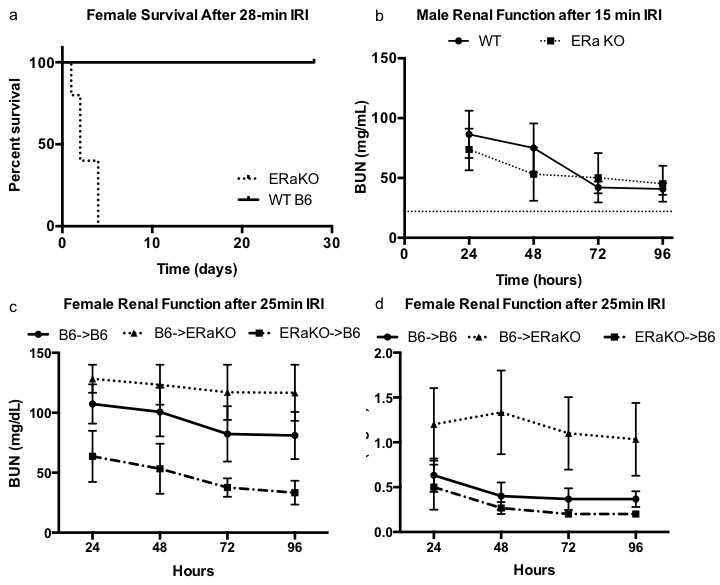Estrogen Receptor Alpha Mediates Female Protection from Renal Ischemia-Reperfusion Injury Through Mechanisms Extrinsic to the Kidney.
1Surgery, University of Pennsylvania, Philadelphia, PA
2Pathology and Laboratory Medicine, Children's Hospital of Philadelphia, Philadelphia, PA
3Pathology and Laboratory Medicine, University of Pennsylvania, Philadelphia, PA
4Surgery, Children's Hospital of Philadelphia, Philadelphia, PA
Meeting: 2017 American Transplant Congress
Abstract number: B114
Keywords: knockout, Mice, Renal injury, Renal ischemia, Warm ischemia
Session Information
Session Name: Poster Session B: Ischemic Injury and Organ Preservation Session II
Session Type: Poster Session
Date: Sunday, April 30, 2017
Session Time: 6:00pm-7:00pm
 Presentation Time: 6:00pm-7:00pm
Presentation Time: 6:00pm-7:00pm
Location: Hall D1
Introduction: Female protection from renal ischemia-reperfusion injury (IRI) is observed in both mouse and human renal transplantation. We wished to assess the role of estrogen receptor alpha (ERa) in mediating this process.
Methods: Wild type (B6) and ERa knockout (ERaKO) C57BL/6 mice underwent 28-min (female) or 15-min (male) warm IRI with clamping of the left renal pedicle and contralateral nephrectomy. Kidneys were transplanted between female WT and ERaKO mice with minimal cold ischemic time, later underwent native nephrectomy, and subsequently underwent standardized 25-min warm IRI of the transplanted kidney. BUN/creatinine was measured daily for 4 days following injury and kidneys were collected for histology after 28 days.
Results: Female ERaKO mice demonstrated significantly diminished survival after renal IRI compared to B6 controls with universal lethality from renal failure within 96 hours of the ischemic injury (p<0.01, Fig 1a). Male ERaKO mice demonstrated equivalent biochemical renal injury (p=0.81, Fig1b) and fibrosis compared to B6 controls. In transplant experiments, mice with extra-renal ERaKO (B6->ESRaKO) demonstrated increased IRI vulnerability compared to renal-restricted ERaKO (ERaKO->B6) or control (B6->B6) mice (p<0.05, Figs 1c & d). Conclusions: Genetic deletion of ERa leads to profound reduction in renal IRI tolerance in female but not male mice. Increased IRI vulnerability persists when ERaKO is confined to extra-renal tissue in females. These finding confirms that sex-specific phenotypes in renal IRI arise from both protective actions of estrogens and detrimental effects of androgens and suggests that ERa plays a mechanistic role in female protection through mechanisms extrinsic to the kidney.
Conclusions: Genetic deletion of ERa leads to profound reduction in renal IRI tolerance in female but not male mice. Increased IRI vulnerability persists when ERaKO is confined to extra-renal tissue in females. These finding confirms that sex-specific phenotypes in renal IRI arise from both protective actions of estrogens and detrimental effects of androgens and suggests that ERa plays a mechanistic role in female protection through mechanisms extrinsic to the kidney.
CITATION INFORMATION: Aufhauser D, Murken D, Wang Z, Ge G, Concors S, Bhatti T, Hancock W, Levine M. Estrogen Receptor Alpha Mediates Female Protection from Renal Ischemia-Reperfusion Injury Through Mechanisms Extrinsic to the Kidney. Am J Transplant. 2017;17 (suppl 3).
To cite this abstract in AMA style:
Aufhauser D, Murken D, Wang Z, Ge G, Concors S, Bhatti T, Hancock W, Levine M. Estrogen Receptor Alpha Mediates Female Protection from Renal Ischemia-Reperfusion Injury Through Mechanisms Extrinsic to the Kidney. [abstract]. Am J Transplant. 2017; 17 (suppl 3). https://atcmeetingabstracts.com/abstract/estrogen-receptor-alpha-mediates-female-protection-from-renal-ischemia-reperfusion-injury-through-mechanisms-extrinsic-to-the-kidney/. Accessed January 6, 2026.« Back to 2017 American Transplant Congress
